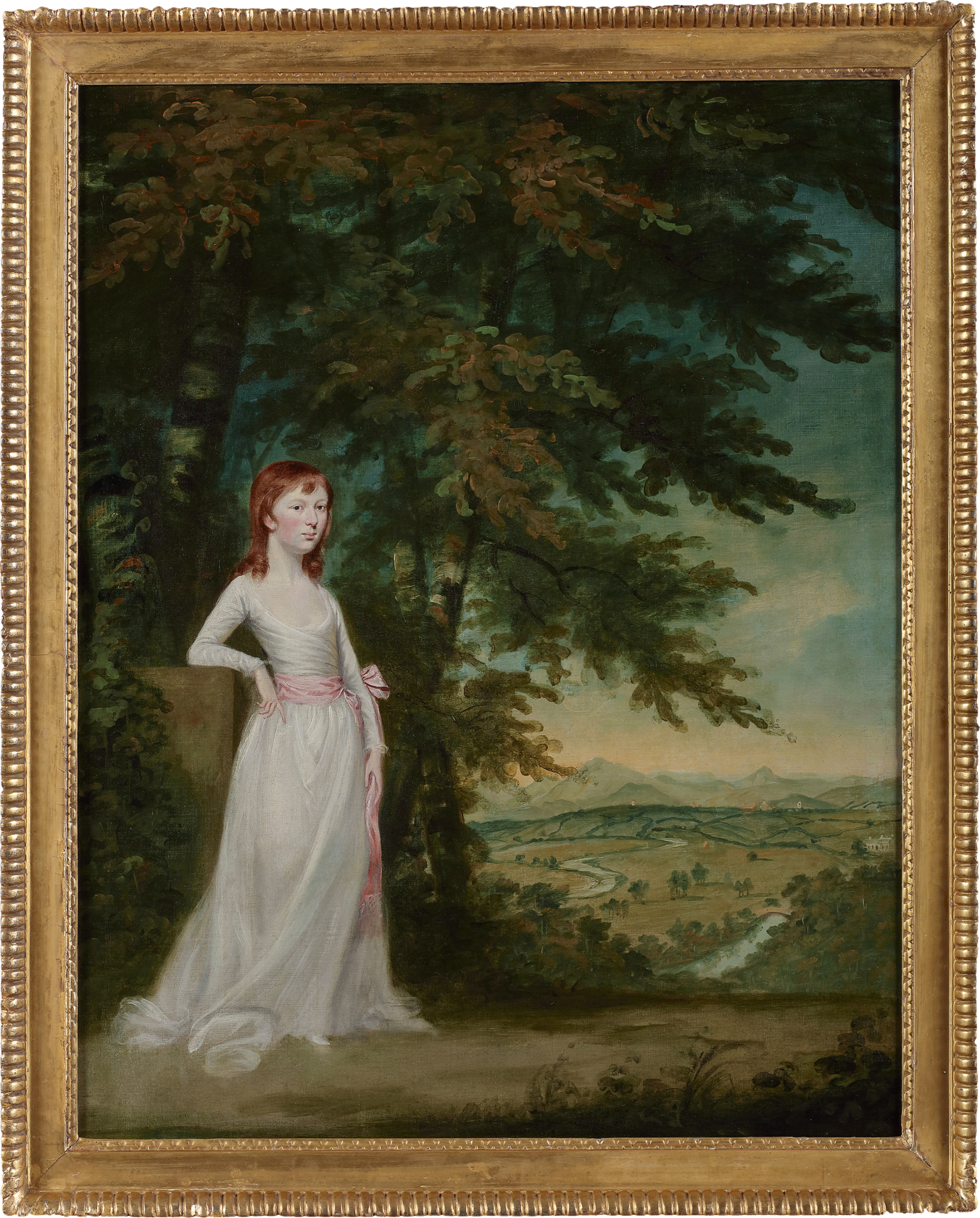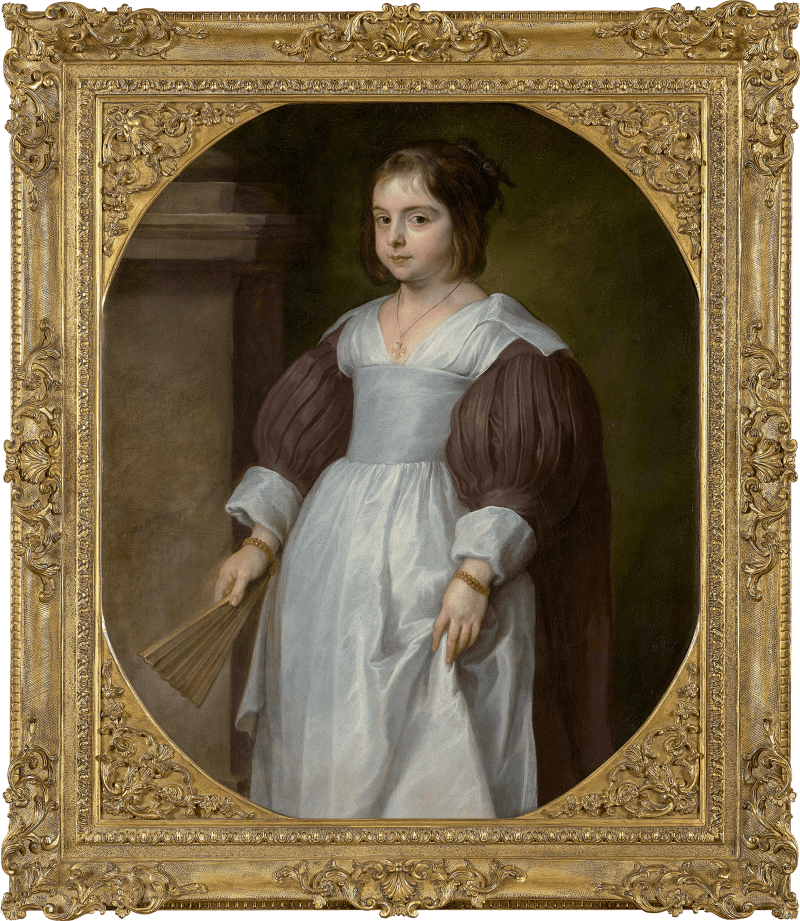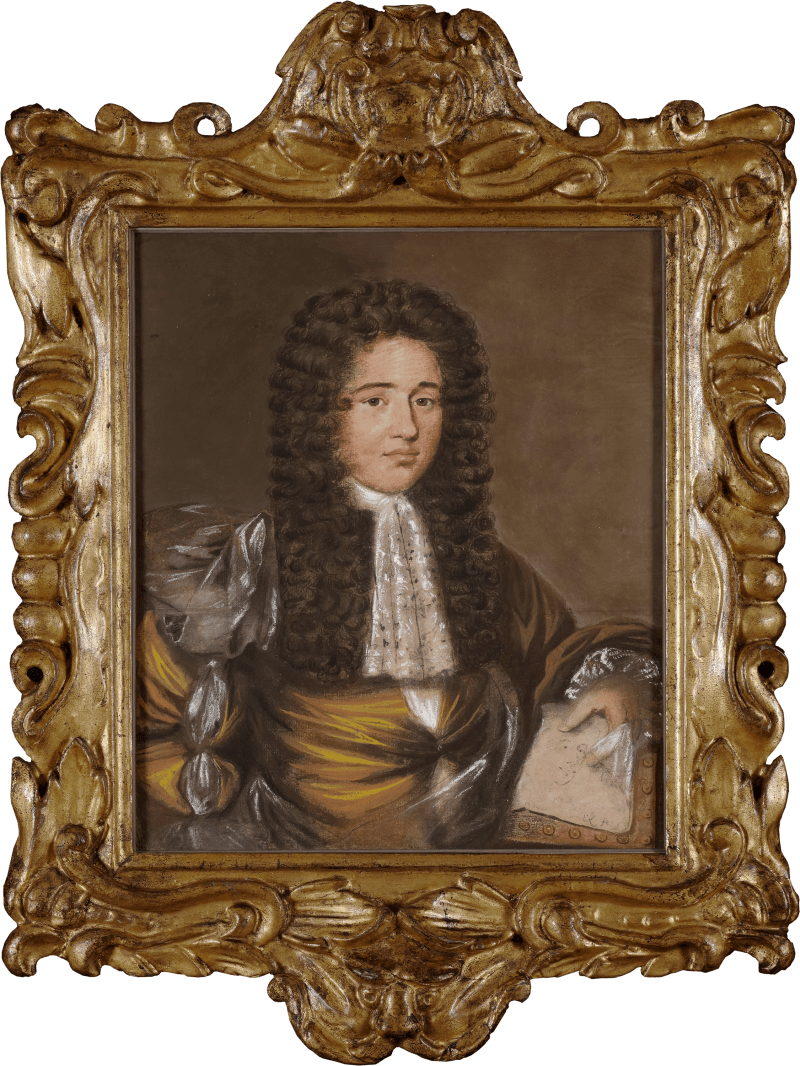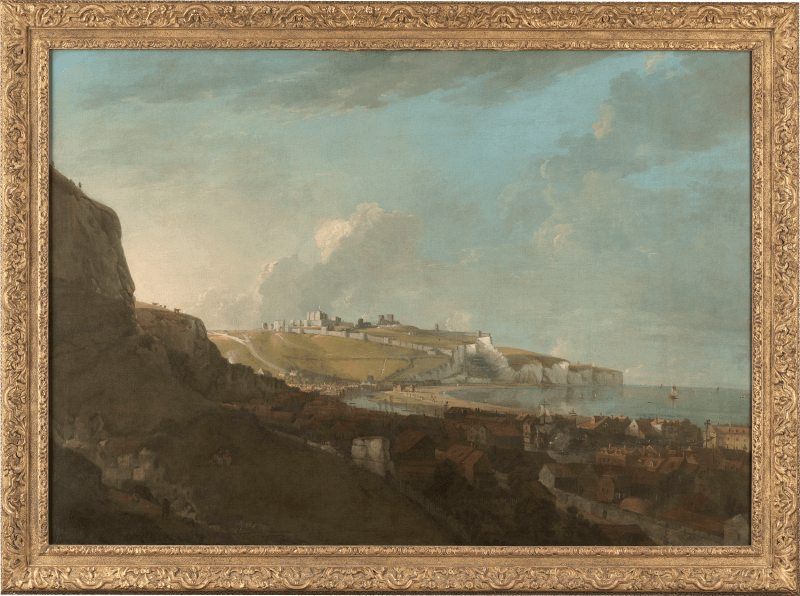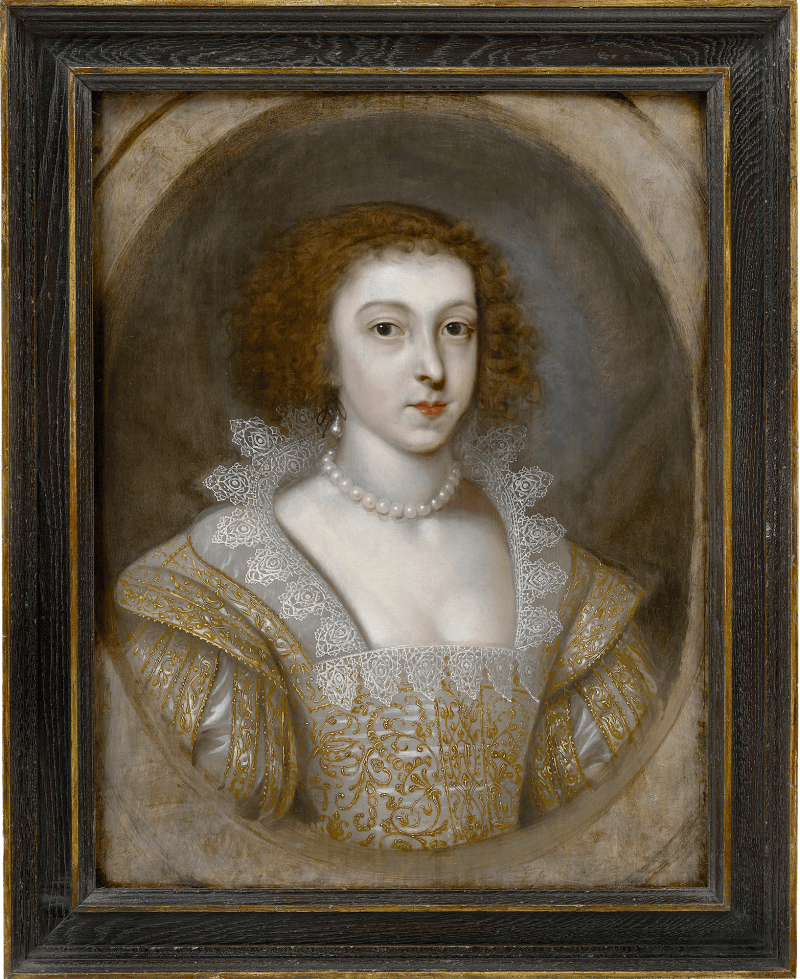This lyrical portrait was painted by Maria Spilsbury, an artist who is largely overlooked in British art studies. It is distinctive for its imaginative fusion of status and sentiment, blending the requirements of formal portraiture with a deep appreciation of nature.
Born into a devout and artistic household, Spilsbury learned her craft from her father, the engraver Jonathan Spilsbury (1737-1812), and studied under Sir William Beechey (1753-1839). [1] She exhibited extensively during the years 1792 – 1813, and attracted long queues of fashionable clientele to her studio in St George’s Row, including the Prince Regent.[2] She gained particular praise and recognition for her portraits of children and works that touched on themes of moral improvement, aimed at an increasingly earnest Victorian audience. Ambitious, multi-figural works such as A Sunday School [fig.1], exhibited at the Royal Academy in 1803, helped secure her reputation. A later biographer described how Spilsbury ‘painted like Fuseli, though Fuseli painted devils and Mrs Taylor painted angels’...
This lyrical portrait was painted by Maria Spilsbury, an artist who is largely overlooked in British art studies. It is distinctive for its imaginative fusion of status and sentiment, blending the requirements of formal portraiture with a deep appreciation of nature.
Born into a devout and artistic household, Spilsbury learned her craft from her father, the engraver Jonathan Spilsbury (1737-1812), and studied under Sir William Beechey (1753-1839). [1] She exhibited extensively during the years 1792 – 1813, and attracted long queues of fashionable clientele to her studio in St George’s Row, including the Prince Regent.[2] She gained particular praise and recognition for her portraits of children and works that touched on themes of moral improvement, aimed at an increasingly earnest Victorian audience. Ambitious, multi-figural works such as A Sunday School [fig.1], exhibited at the Royal Academy in 1803, helped secure her reputation. A later biographer described how Spilsbury ‘painted like Fuseli, though Fuseli painted devils and Mrs Taylor painted angels’ - an astute comparison that captures both the unusual intensity and moral current present within many of her works depicting children.[3] Fellow artist, James Northcote, admired her originality and independence, saying of her: ‘her thoughts are her own, and are often very natural and beautiful’.[4]
The young sitter in this work is identified on the reverse as Jane Bryan of Cong, Co. Galway.[5] Although very little can be gleaned about her life, we do know that a family by this name lived in Castletown townland, near Cong village in Cong civil parish, in the 1850s.[6] The composition suggests that the young sitter had a strong connection to this area of Ireland, as it includes a background resembling the terrain visible from the western side of the narrow strip of land separating Lough Mask from Lough Corrib, between Cong and the village of Maum. This stretch of countryside, celebrated for its scenic walks and unspoilt beauty, attracts many visitors. At that time, Cong was described as “a post-town and parish, partly in the barony of Ross, county of Galway, but chiefly in that of Kilmaine, County of Mayo, and province of Connaught.”[7] Situated on the Galway–Mayo border, it was widely regarded as one of Ireland’s most picturesque and historically resonant destinations, lying some 121 miles west of Dublin. Another portrait by Spilsbury, Miss Jackson of Enniscoe, County Mayo (c.1814–1819) [fig. 2], further attests to the artist’s familiarity with the vistas and atmosphere of the west of Ireland.
Spilsbury moved to Ireland with her young family around 1813 and remained there until she died in 1820. Having spent time in County Wicklow with her parents in c.1789-1790, she formed a long-lasting friendship with the Tighes, a well-connected family of Methodist and evangelical sympathies.[8] The mid-1810s was a period of intense evangelical Protestant activity in Catholic Ireland, carried out by organisations such as the London Hibernian Society, which set up schools, distributed religious materials and sent preachers across the island.[9] The artist’s husband, John Taylor (1784-1821), was part of this movement and founded a Sunday School in Dublin.[10] Like Spilsbury’s other Irish sitters, Jane Bryan was likely a member of a Protestant family connected to the Tighes or other evangelical associates.
Embedded within this compositional design are a number of educational and religious concepts. Spilsbury’s depictions of children – often shown moving along a path in the woods or playing outside a country cottage – were inspired by the revolutionary thoughts on education propounded by John Locke (1632-1704) and Jean-Jacques Rousseau (1712-1778), who advocated for a rural or ‘open air’ upbringing based on unrestricted play and curiosity. Interestingly, a pencil sketch entitled ‘Sunday School’ attached to the verso of this painting depicts an outdoor teaching scene where a preacher with a hat holds the Bible, surrounded by four children of different ages and an old wise man with a beard [fig. 3]. Similar sketches of outdoor lessons can be found in Spilsbury’s sketchbooks held in the National Gallery of Ireland.
Following the precepts of the Moravian Church she imbibed during her childhood, Spilsbury’s art celebrates pious humility and innocence. She depicted most of her sitters dressed in white (a symbol of purity or enlightenment) in an outdoor setting, walking a path that signified ‘spiritual pilgrimage’. The impressive tree, that stands behind the sitter in this work, is probably a Quercus petraea or sessile oak, a native Irish tree found in the Cong Forest. In this case, the oak, a well-known symbol of strength and endurance, may suggest a significant milestone in the young sitter’s life, perhaps Confirmation or the end of schooling.
The present work becomes all the more compelling in light of recent conservation, which has revealed a fascinating insight into its creation. Examination of the canvas suggests that the figure was inserted while the work was still in progress. Perhaps she was removed from another canvas, which was abandoned. The inserted section, though of the same type of canvas, does not align perfectly with the surrounding weave, suggesting it was taken from another piece of the same batch. Crucially, the paint layers are consistent across the join, confirming that this adjustment occurred during the painting’s creation rather than later. Later campaigns of cleaning and overpainting concealed this change until recent restoration revealed the delicate join.
[1] Ruth Young, (1952) Father and Daughter: Jonathan and Maria Spilsbury. 1737-1812; 1777-1820. London: Epworth Press, p. 6.
[2] ‘on private view days, over twenty carriages could be counted’. See Ruth Young, (1952) Father and Daughter: Jonathan and Maria Spilsbury. 1737-1812; 1777-1820. London: Epworth Press, p. 31.
[3] Young, p. 32.
[4] Quoted in Tabitha Barber, ed. (2024). Now You See Us. Women Artists in Britain 1520-1920. London: Tate Publishing, p. 70.
[5] A contemporary wax-sealed inscription ‘Maria Spilsbury / Jane Bryan / of Cong County / Galway’ affixed verso. To date, we have been unable to trace Jane Bryan’s family. The Church of Ireland Archives have checked the existing diocesan registers for Cong and, when available, some of its local parishes (Cong, Ballinchalla, Kilmane, Tuam Cathedral, Kilcoman); the biographical succession lists of Church of Ireland clergy, compiled by J. B. Leslie (1865-1952); and Church of Ireland Parish of Cong. A History of Two Churches compiled by Brigid Clesham. Our thanks to Elizabeth Hassell, Church of Ireland RCB Library Assistant.
[6] This family leased their land from the local Church of Ireland vicar. National Archives of Ireland: Griffith’s Valuation 1847-64; Mayo/Killala/Kilfian Pages 40-41. Our thanks to Michael Walsh (MAGI) for the information.
[7] Samuel Lewis (1837). A Topographical Dictionary of Ireland, available at: https://www.libraryireland.com/topog/C/Cong-Kilmaine-Mayo.php
[8] Mrs Sarah Tighe (1743-1822) was a supporter of the Methodist movement and the evangelical cause. She founded schools and orphan houses and was a friend of the preacher John Wesley (1703-1791), who visited her family in Rossana (a scene later painted by Spilsbury). Mrs Tighe’s son-in-law was the hymn-writer and Anglican evangelical Thomas Kelly, for whom Spilsbury’s husband composed music.
[9] In 1815 the Society established 242 schools, by 1820 there were 529. See A Brief View of the London Hibernian Society for Establishing Schools and Circulating the Holy Scriptures in Ireland (1837). London: London Hibernian Society, p. 3.
[10] John Taylor was the son of businessman and inventor William Taylor of Southampton (1734-1803), a Non-Conformist, supporter of Anglican Evangelicalism, and original director of the London Missionary Society. John was also an inventor and a very pious man. With the help of his brother, he tried to run the family business after the father’s death, but this was eventually dissolved, leaving John without means. See Yeldham, pp. 40-41, 115-16.
